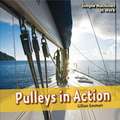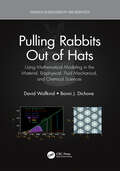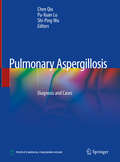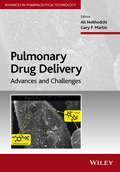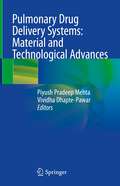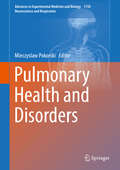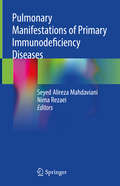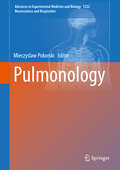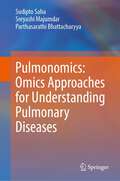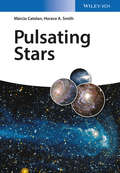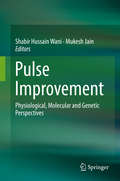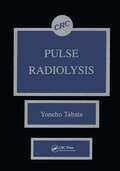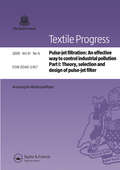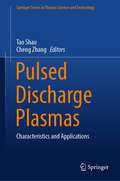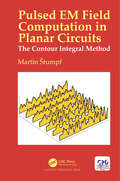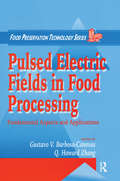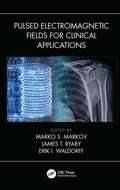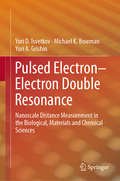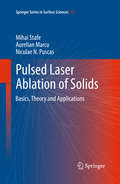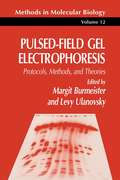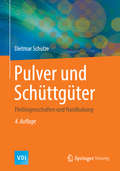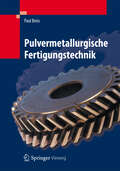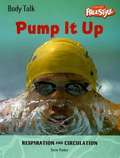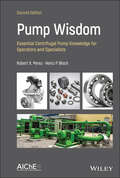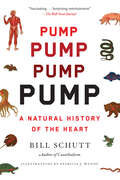- Table View
- List View
Pulleys In Action
by Gillian GosmanThis enlightening book introduces readers to the pulley. Through detailed photographs and uncomplicated text, readers will learn about its basic movement and where they can find pulleys in everyday life.
Pulling Rabbits Out of Hats: Using Mathematical Modeling in the Material, Biophysical, Fluid Mechanical, and Chemical Sciences (Advances in Biochemistry and Biophysics)
by Bonni J. Dichone David WollkindPulling Rabbits Out of Hats: Using Mathematical Modeling in the Material, Biophysical, Fluid Mechanical, and Chemical Sciences focuses on those assumptions made during applied mathematical modeling in which the phenomenological data and the model predictions are self-consistent. This comprehensive reference demonstrates how to employ a variety of mathematical techniques to quantify a number of problems from the material, biophysical, fluid mechanical, and chemical sciences. In doing so, methodology of modelling, analysis, and result generation are all covered. Key Features: Includes examples on such cases as solidification of alloys, chemically-driven convection of dissociating gases, temperature-dependent predator-prey mite systems, multi-layer and two-phase fluid phenomena, viral-target cell interactions, diffusive and gravitational instabilities, and chemical, material science, optical, and ecological Turing patterns. Aims to make the process of quantification of scientific phenomena transparent. Is a hybrid semi-autobiographical account of research results and a monograph on pattern formation. This book is for everyone with an interest in how both scientific contributions are made and mathematical modelling is developed from first principles in STEM fields. For errata, please visit the author's website.
Pulmonary Aspergillosis: Diagnosis and Cases
by Pu-Xuan Lu Chen Qiu Shi-Ping WuThis book provides state-of-the-art information on advances in the diagnosis and treatment of pulmonary aspergillosis to help specialists and clinical practitioners make appropriate decisions concerning the management of patients with this condition. The incidence of pulmonary aspergillosis has increased steadily due to the widespread use of broad-spectrum antibiotics, cytotoxic drugs, immunosuppressive agents and adrenal hormones, as well as the growing number of organ transplantations and AIDS patients. The book discusses various aspects of the disease, including its history, characteristics, laboratory examination, imaging features, clinical diagnosis, differential diagnosis and treatment principles, and also presents illustrated case studies. Focusing on different characteristics in imaging and pathology, and addressing diagnostic difficulties in-depth, this clinical reference work brings together recent clinical investigations to making it a valuable resource for practitioners in the fields of respiratory and infectious diseases, oncology, intensive care, diagnostic imaging, pathology and microbiology.
Pulmonary Drug Delivery
by Gary P. Martin Ali NokhodchiDrug therapy via inhalation route is at the cutting edge of modern drug delivery research. There has been significant progress on the understanding of drug therapy via inhalation products. However, there are still problems associated with their formulation design, including the interaction between the active pharmaceutical ingredient(s) (APIs), excipients and devices. This book seeks to cover some of the most pertinent issues and challenges of such formulation design associated with industrial production and desirable clinical outcome. The chapter topics have been selected with a view to integrating the factors that require consideration in the selection and design of device and formulation components which impact upon patient usability and clinical effectiveness. The challenges involved with the delivery of macromolecules by inhalation to both adult and pediatric patients are also covered. Written by leading international experts from both academia and industry, the book will help readers (formulation design scientists, researchers and post-graduate and specialized undergraduate students) develop a deep understanding of key aspects of inhalation formulations as well as detail ongoing challenges and advances associated with their development.
Pulmonary Drug Delivery Systems: Material and Technological Advances
by Piyush Pradeep Mehta Vividha Dhapte-PawarThis book provides an insight into state-of-art developments in pulmonary drug delivery systems. It comprises several chapters covering a wide range of promising technologies and novel materials explored for developing effective pulmonary drug delivery systems. The initial book chapters elucidate role of thin film freezing, supercritical fluid technology, nano-in-micro particles system, crystal-engineered microstructures and porous particles in pulmonary drug delivery. The subsequent book chapters elaborate on various functional excipients such as chitosan, cyclodextrins, and Vitamin E-TPGS to attain local and systemic therapeutic action. There are book chapters focused on diverse novel carrier systems such as hydrogels, quantum dots, metal-organic framework, and prodrug approach. Additionally, book also contains chapters, exclusively dedicated to biologicals and numerical simulation in pulmonary therapeutics. The book chapters follow a sequential order, beginning with the pulmonary relevance of technology or polymeric materials, carrier synthesis schemes, current technical state-of-art, along with clinical, industrial, and regulatory aspects. Each chapter contains a future perspective section that will systematically reflect the current state of advances in pulmonary drug delivery. It also offers a practical basis for audience to understand the design and function of the delivery systems for better therapeutic outcomes. The book provides balanced views by considering the investigations from various scientific domains and industrial knowledge. Briefly, this book aims to collect, analyse, and bring together the latest developments in pulmonary drug delivery with more focus on materials and technologies. Indeed, this book is a valuable source for readers and researchers who wish to learn more about the advances in pulmonary drug delivery systems.
Pulmonary Health and Disorders (Advances in Experimental Medicine and Biology #1150)
by Mieczyslaw PokorskiThis book presents original articles that report on new approaches and developments involving pulmonary disorders. Pulmonary health attracts public concern as lungs are the first line of defense of the organism against various contagions and are directly influenced by all too often unhealthy constituents of ambient air, which make them vulnerable to diseases. The articles deal with the pathogenic background and most relevant practical aspects of the widespread pulmonary disorders. Topics include the mechanisms and treatment options of sleep apnea syndrome, occupational exposure to carbon dioxide, and the research on prognostic factors in lung cancer. Another theme tackles quality of life in chronic pathologies and the psychosocial factors, often underestimated, having influence on lung function already in adolescence, and thus liable to shape adult pulmonary morbidity. Reports on the course of recent influenza outbreaks and a rather dismal state of anti-influenza measures top off the content. The volume is addressed to clinicians and researchers, pulmonary doctors, and other professionals engaged in patient care and therapy.
Pulmonary Manifestations of Primary Immunodeficiency Diseases
by Nima Rezaei Seyed Alireza MahdavianiThis book provides a broad overview of the respiratory manifestations associated with Primary Immune deficiencies (PID) congenital genetic defects such as infections, chronic inflammation, autoimmunity, lymphoproliferation, allergic manifestations and rare forms of cancer. Since the most common site of involvement in PID is the lung, the pulmonologists (pediatrics or adult), Internists and General Practitioners may be among the first to recognize the pattern of pulmonary disorders, leading to diagnosis of PID. Pulmonary complications present a significant cause of morbidity and also mortality among patients suffering from different forms of PID. With the prevalence of lung infections and disease so high in PID patients, respiratory professionals will find this book to be an essential resource for diagnosing, managing and referring PID related pulmonary disorders in clinical practice.
Pulmonology (Advances in Experimental Medicine and Biology #1222)
by Mieczyslaw PokorskiThis book addresses several burning issues concerning diseases involving the lungs and respiratory tract.It discusses the epidemiology, mechanisms, prevention, and diagnosis of chest conditions such as chronic obstructive pulmonary disease, sleep apnea and respiratory infections. Further, it examines the intertwined connection between oxidative stress, cardiovascular disorders such as hypertension, and the occurrence and course of obstructive sleep apnea. It also provides pulmonologists with valuable information on the diagnosis and treatment of patients with severe airway obstruction or respiratory tract infections. Other topics covered include viral infections of the airways, such as influenza, particularly in high-risk groups like pediatric populations, as well as psychosocial aspects, e.g., quality of life in lung cancer patients. Combining basic science and clinical practice, the articles provide key insights and highlight the areas of still limited understanding of disease processes. Stimulating new directions in clinical practice, this collection of articles is intended for respiratory physicians, clinical experts, family practitioners, and all allied healthcare professionals.
Pulmonomics: Omics Approaches for Understanding Pulmonary Diseases
by Sudipto Saha Sreyashi Majumdar Parthasarathi BhattacharyyaThis book comprehensively reviews various omics approaches like genomics, proteomics, transcriptomics, and metabolomics for understanding pulmonary disease at molecular and systems levels. The initial chapters present the pathogenesis of major pulmonary diseases, namely, obstructive diseases, restrictive diseases, vascular diseases, infectious diseases, and neoplastic carcinoma. The book chapters provide current information about the role of the microbiome and applications of medical imaging, bioinformatics tools, and databases for diagnosis and designing treatment strategies against complex lung diseases. Further, the book discusses omics technologies to identify biomarkers for the early diagnosis and prognosis of pulmonary diseases. Finally, the book elucidates the multi-omics approaches and data integration using mathematical modeling for insights into the disease etiology towards improving the prognostics and predictive accuracy of disease phenotypes.
Pulsating Stars
by Horace A. Smith Márcio CatelanThis book surveys our understanding of stars which change in brightness because they pulsate. Pulsating variable stars are keys to distance scales inside and beyond the Milky Way galaxy. They test our understanding not only of stellar pulsation theory but also of stellar structure and evolution theory. Moreover, pulsating stars are important probes of the formation and evolution of our own and neighboring galaxies. Our understanding of pulsating stars has greatly increased in recent years as large-scale surveys of pulsating stars in the Milky Way and other Local Group galaxies have provided a wealth of new observations and as space-based instruments have studied particular pulsating stars in unprecedented detail.
Pulse Improvement: Physiological, Molecular and Genetic Perspectives
by Shabir Hussain Wani Mukesh JainAdvances in molecular biology and genome research in the form of molecular breeding and genetic engineering put forward innovative prospects for improving productivity of many pulses crops. Pathways have been discovered, which include regulatory elements that modulate stress responses (e.g., transcription factors and protein kinases) and functional genes, which guard the cells (e.g., enzymes for generating protective metabolites and proteins). In addition, numerous quantitative trait loci (QTLs) associated with elevated stress tolerance have been cloned, resulting in the detection of critical genes for stress tolerance. Together these networks can be used to enhance stress tolerance in pulses. This book summarizes recent advances in pulse research for increasing productivity, improving biotic and abiotic stress tolerance, and enhancing nutritional quality.
Pulse Radiolysis of Irradiated Systems
by Yoneho TabataPulse Radiolysis presents an in-depth discussion of the pulse radiolysis technique, one of the most important and powerful means for detecting transient and relaxation phenomena and following their behavior in irradiated systems. The book covers the principle of pulse radiolysis, identifies various kinds of pulse radiolysis techniques, and discusses recent advancements in the field. The text also discusses new experimental pulse radiolysis techniques (basic and applied) in broad scientific fields such as physics, chemistry, biology, and engineering. These techniques include picosecond pulse radiolysis, single particle radiolysis, and muon-induced transient phenomena. Pulse Radiolysis provides essential information for all professionals involved with pulse radiolysis research.
Pulse-Jet Filtration: Part 1: Theory, Selection and Design of Pulse-Jet Filter
by Arunangshu MukhopadhyayThis book provides the fundamental concept of design and development of pulse-jet filters under varied situations. It discusses technical and commercial solutions for successful operation of textile industries integrated with pollution control equipment maintaining clean air requirements.
Pulsed Discharge Plasmas: Characteristics and Applications (Springer Series in Plasma Science and Technology)
by Cheng Zhang Tao ShaoThis book highlights the latest progress in pulsed discharge plasmas presented by front-line researchers worldwide. The science and technology surrounding pulsed discharge plasmas is advanced through a wide scope of interdisciplinary studies into pulsed power and plasma physics. Pulsed discharge plasmas with high-power density, high E/N and high-energy electrons can effectively generate highly reactive plasma. Related applications have gathered strong interests in various fields. With contributions from global scientists, the book elaborates on the theories, numerical simulations, diagnostic methods, discharge characteristics and application technologies of pulsed discharge plasmas. The book is divided into three parts with a total of 35 chapters, including 11 chapters on pulsed discharge generation and mechanism, 12 chapters on pulsed discharge characterization and 12 chapters on pulsed discharge applications (wastewater treatments, biomedicine, surface modification, and energy conversion, etc). The book is a must-have reference for researchers and engineers in related fields and graduate students interested in the subject.
Pulsed EM Field Computation in Planar Circuits: The Contour Integral Method
by Martin StumpfThe pulsed EM characterization of planar circuits is of high practical importance in many areas of science and engineering such as electromagnetic compatibility and antenna design. This book is hence devoted to the mathematical formulation and numerical analysis of arbitrarily-shaped parallel-plane structures concerning their pulsed EM propagation, radiation and scattering behavior. The key emphasis is on the time-domain reciprocity-based integral-equation formulations and their efficient numerical solution.
Pulsed Electric Fields in Food Processing: Fundamental Aspects and Applications (Food Preservation Technology)
by Q. Howard Zhang Gustavo V. Barbosa-CanovasPulsed Electric Fields (PEF) is one of the nonthermal processing approaches that is receiving considerable attention by scientists, government and the food industry as a potential technique to be fully adopted to process foods at the industrial level. PEF presents a number of advantages including minimal changes to fresh foods, inactivation of a wi
Pulsed Electromagnetic Fields for Clinical Applications
by Marko S. Markov James T. Ryaby Erik I. WaldorffPulsed Electromagnetic Fields for Clinical Applications presents the historical development, the state of art, and the future of the application of pulsed electromagnetic fields (PEMFs) for the treatment of various medical problems, including initiating various healing processes from delayed fractures and pain relief to multiple sclerosis and Parkinson’s disease. The emphasis is on the development of scientific methods to be implemented in clinical application. In perspective, this modality provides a practical, exogenous method for inducing cell and tissue modification attempted to the injured tissues to their normal physiological status. The book reviews the current state of equipment for PEMFs and highlights worldwide therapeutic achievements. It explores the past, present, and future of PEMF therapies. It presents the development of theory and laboratory research during the last 70 years. It reviews the available equipment for PEMF. It reviews the state of the art of worldwide therapeutic achievements. It includes recent achievements and applications of electroporation modalities.
Pulsed Electron–Electron Double Resonance: Nanoscale Distance Measurement in the Biological, Materials and Chemical Sciences
by Yuri D. Tsvetkov Michael K. Bowman Yuri A. GrishinThis book covers the basic theory and techniques, as well as various applications of pulsed electron–electron double resonance (PELDOR or DEER). This electron paramagnetic resonance technique is able to measure the distances and the distribution of distances between electron spins in the 1.5–15 nanometer scale; to determine the geometry of spin-labeled molecules; to estimate the number of interacting spins in spin clusters; and to characterize the spatial distribution of paramagnetic centers. As a result, PELDOR is now a popular method in EPR spectroscopy, particularly in the context of biologically important systems and soft matter and is also applied to problems in physical chemistry, biochemistry, polymers, soft matter and materials. Enabling readers to gain an understanding of the fundamentals of the PELDOR methods and an appreciation of the opportunities PELDOR provides, the book helps readers solve their own physical and biochemical problems.
Pulsed Laser Ablation of Solids
by Mihai Stafe Aurelian Marcu Niculae N. PuscasThe book introduces 'the state of the art' of pulsed laser ablation and its applications. It is based on recent theoretical and experimental studies. The book reaches from the basics to advanced topics of pulsed laser ablation. Theoretical and experimental fundamental phenomena involved in pulsed laser ablation are discussed with respect to material properties, laser wavelength, fluence and intensity regime of the light absorbed linearly or non-linearly in the target material. The energy absorbed by the electrons leads to atom/molecule excitation, ionization and/or direct chemical bond breaking and is also transferred to the lattice leading to material heating and phase transitions. Experimental non-invasive optical methods for analyzing these phenomena in real time are described. Theoretical models for pulsed laser ablation and phase transitions induced by laser beams and laser-vapour/plasma interaction during the plume expansion above the target are also presented. Calculations of the ablation speed and dimensions of the ablated micro- and nano-structures are performed. The validity and required refinement of different models in different experimental conditions is provided. The pulsed laser deposition process which bases on collecting the ablated particles on a surface is analyzed in terms of efficiency and quality of the deposited films as a function of ambient conditions, target material, laser parameters and substrate characteristics. The interaction between the incident laser and the ablation plasma is analyzed with respect to its influence on the structures of the deposited films and its capacity to generate high harmonics and single attosecond pulses which are highly desirable in pump-probe experiments.
Pulsed-Field Gel Electrophoresis
by Levy Ulanovsky Margit BurmeisterBurmeister and Ulanovsky's new volume on Pulsed-Field Gel Electrophoresis presents step-by-step protocols for all users of this powerful methodology, whether novice or expert. The book features a wide range of PFGE techniques, auxiliary methods, and a diverse array of powerful applications. Each protocol is given thorough treatment by authors who have had extensive hands-on-experience with it. Indeed, many of the contributors have long provided assistance and troubleshooting advice to new users of PFGE during the early stages of its growth. Here they incorporate the benefits of their experience in the extensive Notes sections, which describe common problems and pitfalls and offer sensible solutions for dealing with them. Topics and techniques treated include: * FIGE, CHEF, OFAGE, TAFE, FORE, ODPFGE * preparation of DNA suitable for PFGE from: bacteria, protozoa, plants, mammals, and yeasts. * preparation and analysis of yeast artificial chromosomes (YACS) * mapping strategies * biological applications * theories and observations. In keeping with the well-known practicality of Humana's Methods in Molecular Biology series, Pulsed-Field Gel Electrophoresis brims with protocols designed to work even the first time they are used.
Pulver und Schüttgüter: Fließeigenschaften und Handhabung (VDI-Buch)
by Dietmar SchulzeErfahren Sie in diesem Buch alles über die Eigenschaften von Pulvern und Schüttgütern sowie deren Anwendung in der PraxisDas theoretische Wissen um das Verhalten von Pulvern und Schüttgütern ist im Ingenieurwesen mittlerweile weit verbreitet. Beim Blick in die Praxis – speziell bei der Schüttgutlagerung in Silos – fehlt es jedoch nach wie vor an Vertrauen in diese Methode. Das möchte Dietmar Schulze mit diesem Buch über Pulver und Schüttgüter ein für alle Mal ändern. In seinem Buch erläutert er daher die Fließeigenschaften und -fähigkeiten dieser Komponenten und zeigt, wie dieses Wissen in die Gestaltung von Anlagenteilen wie Trichtern oder Silos praktisch angewendet werden kann. Anhand von Berechnungsaufgaben mit Lösungen können Sie Ihren aktuellen Wissensstand prüfen und erweitern.Von der Theorie zur Gestaltung von SchüttgutbehälternSchulze hat sein Buch über Pulver und Schüttgüter in zwei Bereiche aufgeteilt. In drei Kapiteln erörtert er die theoretischen Grundlagen zum Umgang mit Schüttgütern im Ingenieurwesen. Hier lernen Sie alles über: • Wechselwirkungen zwischen Partikeln• Fließeigenschaften und deren Messung• Einflüsse auf das Fließverhalten (z.B. Feuchtigkeit, Zeit, Fließhilfsmittelgehalt)Nach diesem theoretischen Grundlagen-Exkurs wendet sich der Autor der Schüttguttechnik in der Praxis zu. Schulze erläutert, wie Sie die gemessenen Fließeigenschaften zur funktionsgerechten Gestaltung von Schüttgutbehältern wie Silos und Trichtern anwenden können. Zudem bekommen Sie einen Einblick in apparative Aspekte sowie das praktische Messen von Fließeigenschaften – insbesondere mit Hilfe von Schergeräten.Die vierte, ergänzte Auflage – ideal für NeueinsteigerAbschließend befasst sich dieses Buch mit der verfahrenstechnischen Siloauslegung. Hier widmet sich der Autor Aspekten wie der Silogestaltung, dem Schüttgutaustrag, der Entmischung sowie dem Phänomen von Erschütterungen und Schwingungen in Silos. Für die vierte Auflage wurden in mehreren Kapiteln Ergänzungen vorgenommen, u.a. bei der Entmischung zur Probenahme und zur Bewertung der Mischungsqualität mittels statistischer Methoden, und bei der Siloauslegung mit weiteren Berechnungsdiagrammen.
Pulvermetallurgische Fertigungstechnik
by Paul BeissUnter den Oberbegriff Pulvermetallurgie fällt eine große Vielfalt an Verfahren und Produkten, von denen die Strukturwerkstoffe in der Technik die größte Wertschöpfung und Anwendungsbreite haben. Dazu sind sehr unterschiedliche Aufbereitungs- und Formgebungsverfahren entwickelt worden, die auf den Verarbeitungseigenschaften der jeweiligen Pulver beruhen. Eine Auswahl dieser Verfahren mit größerer technischer Bedeutung wird geschildert. Für Pulver, die unter Druck Grünfestigkeit entwickeln, hat das Matrizenpressen bei Raumtemperatur oder wenig erhöhten Temperaturen für die Formgebung von Bauteilen bis etwa fünf Kilogramm Masse mit weitem Abstand die wirtschaftlich größte Bedeutung. Hierzu gibt es zahlreiche Varianten für spezielle geometrische Anforderungen, z. B. Hinterschneidungen, die ausführlicher beschrieben werden. Im gepressten Zustand ist die Grünfestigkeit der Festigkeit von Kreide vergleichbar. Für die technische Anwendung bedarf es einer metallurgischen Konsolidierung durch Sintern, die aus wirtschaftlichen Gründen in schutzgasgefüllten kontinuierlichen Öfen unter Atmosphärendruck abläuft. Die Sinterbedingungen und bei kohlenstoffhaltigen Legierungsstählen die Abkühlbedingungen bestimmen das Gefüge und zusammen mit der Dichte die Festigkeitseigenschaften. Auf diese Prozesse wird detailliert eingegangen. Den Abschluss der Darstellung bildet eine umfangreiche Übersicht über mechanische und thermophysikalische Eigenschaften von Sinterstählen, besonders auch über deren Schwingfestigkeit.
Pump It Up: Respiration and Circulation
by Steve ParkerTake a new look at the human body. Find out how your heart, lungs, and blood work together to keep you alive. Using interesting photos and facts, this book will really make you think about your body and the amazing things that go on inside you every second. You'll never feel the same way about yourself!
Pump Wisdom: Essential Centrifugal Pump Knowledge for Operators and Specialists
by Heinz P. Bloch Robert X. PerezExplore key facets of centrifugal pump ownership, installation, operation, and troubleshooting The Second Edition of Pump Wisdom: Essential Centrifugal Pump Knowledge for Operators and Specialists delivers a concise explanation of how pumps function, the design specifications that must be considered before purchasing a pump, and current best practices in lubrication and mechanical seals. Readers will encounter new startup and surveillance tips for pump operators, as well as additional repair and replace considerations for maintenance decision makers, new condition monitoring guidance for centrifugal pumps, and expanded coverage of operator best practices. This latest edition of Pump Wisdom includes expanded coverage of areas critical to achieving best-in-class pump reliability, including commonly encountered issues and easy-to-follow instructions for getting centrifugal pumps to operate safely and reliably. This book also provides: Comprehensible and accessible explanations of pump hydraulics Simple explorations of the mechanical aspects of pumps with coverage of bearings, seals, impeller trimming, lubricant application, and more Safety tips and instructions for centrifugal pumps Perfect for chemical, petroleum, and mechanical engineers, Pump Wisdom: Essential Centrifugal Pump Knowledge for Operators and Specialists is also an ideal resource for operators, managers, purchasing agents, machinists, reliability technicians, and maintenance workers in water and wastewater plants.
Pump: A Natural History of the Heart
by Bill Schutt"Fascinating . . . Surprising entertainment, combining deep learning with dad jokes . . . [Schutt] is a natural teacher with an easy way with metaphor.&” —The Wall Street Journal A journey into the heartbeat of life on Earth. Millennia ago, when we first began puzzling over the mysteries of the human body, one organ stood out as vital. The heart was warm, it was central, and it moved as it pumped blood. The ancient Egyptians treated it with reverence, mummifying it separately from the body so that the soul inside it could be weighed. Aristotle believed that it was the seat of consciousness. Over the centuries, science has dispelled the myths, but our fascination with the heart has endured. From the origins of circulation, still evident in some microorganisms today, to the enormous hearts of blue whales, we journey with Bill to beaches where horseshoe crabs are being harvested for their life-saving blood, and under the sea to learn about the world&’s most natural antifreeze, flowing through the veins of icefish. And we follow him through human history, too, as scientists hypothesize wrongly and rightly about what is arguably our most important organ, ultimately developing the technologies that have helped us study the heart—and now, in the most cutting-edge labs, the tools that will help us regenerate it. Deeply researched and engagingly told, Pump is a fascinating natural history sure to be loved by readers of Mary Roach and Bill Bryson.
